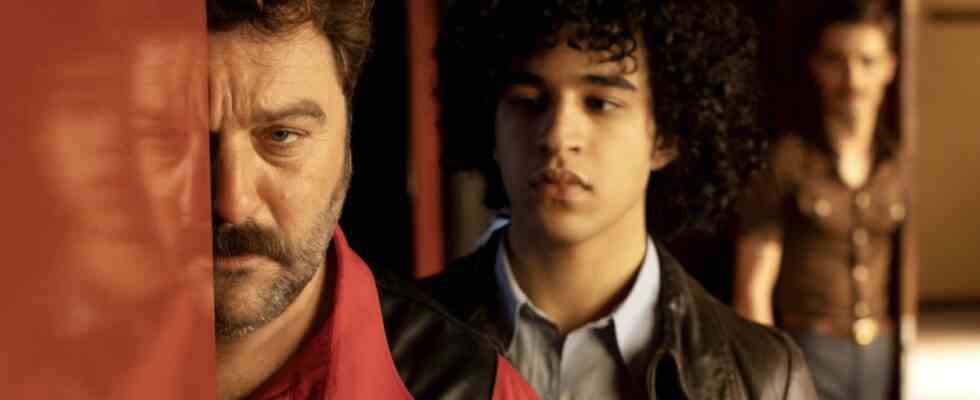Peter von Kant, very drunk and very alone, dances through his apartment, which is bathed in cold, dark blue light. Rather, he staggers. Desperately, in his dressing gown, he waits for the call of the young actor whose large-format picture adorns his wall, shirtless and in the pose of Saint Sebastian: Amir. Peter once loved Amir and made him famous, then he left him. There, a call: But no, it’s not Amir, just some well-wisher. It’s Peter von Kant’s birthday.
A chanson by Cora Vaucaire, “Comme au théâtre”, is playing on the record player, in which a woman also remembers a past love affair and calls after her lover in the past that the more she thinks about it, he is “a genius of mise en scene”. A brilliant director. At that moment, one imagines that François Ozon would talk in the same way about Rainer Werner Fassbinder, whom he mourns for, whom he remade in his film “Peter von Kant” and at the same time evokes.
Fassbinder’s 1972 chamber play The Bitter Tears of Petra von Kant, based on his play of the same name, was set in the studio apartment of wealthy, successful fashion designer Petra von Kant, played by Margit Carstensen. Petra von Kant falls unhappily in love with a young model (Hanna Schygulla) who makes her big, only to be dumped by him while she orders her secretary, the mute Marlene (Irm Hermann), around like a slave.
It was all not just one of those ruthless Fassbinderian explorations of money, love and power, but also a moment of genius Mise en scenealong the long, winding tracking shots of Michael Ballhaus, who turned the cramped place into a sprawling labyrinth of torment and a shrine to the art of cinema.
At the center is a tyrant director who falls prey to impossible passions
Fassbinder’s film was often read in an (auto-)biographical way, as the master’s commentary on his self-created, highly productive and highly toxic environment. The focus is on the director tyrant who exploits his employees while he himself falls prey to the most unlikely passions. Ozon takes advantage of this reading in this homage to Fassbinder, whose photo he already shows during the opening credits.
Peter von Kant is a famous German director and the whole thing takes place in the year of Fassbinder’s film, 1972, although not in Bremen like the original, but in Cologne, in the apartment of the title hero. Denis Ménochet is allowed to walk around in a black leather vest with a red shirt and coke properly. He falls in love with said actor (Khalil Ben Gharbia) and gets a visit from an actress and singer friend (Isabelle Adjani, not exactly at the peak of her abilities), who reminds him and us that Kant alias Fassbinder is a great artistic figure and human was a big sow. The secretary from back then has become the pale secretary Karl, he doesn’t say a word either, he too has to be bossed around.
Ozone, on the other hand, packs it all into a sterile, friendly atmosphere, space, and color spectrum that looks like today’s standard quality television à la Netflix. If Fassbinder’s cuts were clearly recognizable, if the figures were picked up again and again and found again and again, in positions that were just as specific as the mannequins that stood around in the apartment, with Ozon the cuts are arbitrary and conform to television standards. No resistance stands in the way of the eye, the narrative is homogenized and smoothed out. Everything is nice and clean, and even when he’s drunk on the coke, Kant keeps his composure.
And the lyrics? Fassbinder’s way of speaking analyzed what was said, the emphasis on words like “regret” and “understand” had the same weight as a shot of the downtrodden secretary Marlene’s face, which was suddenly blurred. In those moments we too understood and felt the regret of the fashion designer in her golden cage.
However, Ozon lets the dialogues tumble down too quickly; the adaptation is faithful to the original, but the anguish is gone. Is man, as it says in “Bitter Tears”, made in such a way “that he needs the other without having learned how to be with him”? Ballhaus’s camera movement blocks credibly pressed people into this tension – Ozone has lost none of this.
The artist and his mother: Hanna Schygulla and Denis Ménochet in “Peter von Kant”.
(Photo: Carole Bethuel/MFA)
Because Kant dances alone, and this new adaptation – which was allowed to open the Berlinale in the spring – is more of a mental cinema in the imagination of the cinephile French filmmaker, who has repeatedly resorted to film historical templates by Lubitsch or Cronenberg in his last films. Apart from Hanna Schygulla, who has a guest appearance as Kant’s mom, the actors and actresses are from France and speak French. Kant is thus more of a Frenchized fantasy cooper of Ozone than having any connection to the original.
Now Ozon knows exactly where it is in film history. He knows that today, in the year 2022, one can only pay homage to an artist monolith like Fassbinder ironically. Kant is sometimes a narcissistic artist and then again a defiant, tearful, somehow ridiculous child with folded arms: a toxic teddy bear who first cholerically yells at the women around him, only to then let “Mother” Schygulla sing him to sleep. The genius of Mise en scene has long since said goodbye. The drunken dances remain.
Peter von Kant, France / Belgium 2022. – Director: François Ozon. Book: Ozone, based on the film by Rainer Werner Fassbinder. Camera: Manuel Dacosse. With Denis Menochet, Isabelle Adjani, Khalil Ben Gharbia. MFA / film agents, 85 min. Theatrical release: September 22, 2022.

